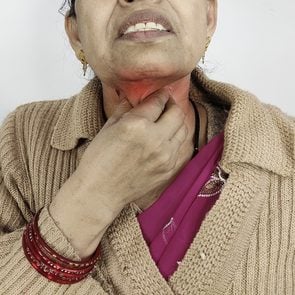For Years, Her Excruciating Stomach Pain Would Strike at Random—And Doctors Were Stumped

Every time Genevieve made it to the ER, her debilitating symptoms would vanish as quickly as they'd appeared...
One evening in June 2010, Genevieve Crean was working late at Cal Poly Pomona, a university just east of Los Angeles. Crean, a therapist who was in her early 60s at the time, was known around campus for her easy sense of humour and warm smile. But that night, she wasn’t smiling. Without warning, she had the most awful stomach ache of her life. It was an intense pressure, as if her guts were being squashed.
Crean called her husband, John, to pick her up and take her to the emergency room. By the time a doctor could see her, the pain was gone. “They shrugged and told me to follow up with my GP,” she says. “I thought maybe it was just a one-time fluke.”
A year and a half later, however, the pain returned while Crean was at a conference in L.A. “It was just excruciating,” she says. “It was like childbirth without the baby.” And this time, it was accompanied by cold sweats and vomiting. Crean went to the ER again, where the same pattern unfolded: by the time she was seen, the episode was over, and the doctors couldn’t find anything wrong with her. She was relieved it had ended, but she began to worry it would become a recurring problem.
The next year confirmed her fears. Once or twice a month, her stomach would erupt in pain for anywhere from an hour to four hours or longer. It happened at random—in the middle of dinner, during a wedding reception, on a work trip. Her usual response was to take painkillers, curl up into the fetal position and pray it would pass. “God was right there with me during those episodes,” she says. “It didn’t decrease the pain, but it gave me mental relief.”
Searching for Answers
With the help of her husband, Crean spent the next several years searching for answers. They visited a variety of medical experts, including a gastroenterologist and an obstetrician-gynecologist. The doctors scanned her stomach, ran blood and urine tests and checked for allergies, but everything came back normal. At her doctors’ advice, she tried switching her diet, eliminating raw fruit and vegetables and ingesting homeopathic oils, all to no avail. One surgeon removed her gallbladder, which can sometimes cause symptoms like Crean’s, but the episodes stubbornly continued. Her gastroenterologist suggested Crean might have nutcracker syndrome, a rare condition in which a vein flowing from the kidney is compressed. The diagnosis turned out to be another dead end.
Even after all the consultations, no one was sure what was ailing her. Crean’s doctors prescribed her an opiate called hydrocodone to manage the pain. Wanting to still live her life to the fullest, she travelled when she could, but in the back of her mind she was always concerned about possible flare-ups while abroad. She began to worry whether this would forever affect her life. “Am I going to be a little old lady with these terrible pains still afflicting me?” she wondered.
The Missing Piece of the Puzzle
In 2018, Crean got a referral to the Cedars-Sinai Center for the Undiagnosed Patient (CUP) in Los Angeles, a multidisciplinary program dedicated to tough cases. “The average doctor can’t take an entire day or week for one patient,” says Dr. Edward Phillips, Cedars-Sinai’s director of general surgery. But at CUP, physicians are given the time to sift through what can sometimes be thousands of pages of patient records to find the missing piece of their diagnostic puzzle.
When Phillips reviewed Crean’s medical history, he realized that while many doctors had scanned her stomach, no one had run imaging during one of her attacks. So, he asked Crean to go to her local hospital the next time she had an episode, which ended up being around Mother’s Day in 2019. When she got there, a team was waiting to perform a CT scan.
When Phillips saw the scan, he says, “it was a eureka moment.” It revealed that the upper section of Crean’s small intestine was dilated—much wider than its usual one-centimetre diameter—while the lower section was collapsed, indicating an obstruction somewhere along the way. Upon further inspection, he discovered that a loop of Crean’s bowel was trapped inside a gap in her pelvis—a space through which the femoral arteries and veins, which carry blood to and from the lower body, travel. Most of the time, the bowel was perfectly normal, which explains why no previous scans had detected the problem. But occasionally, when the loop got stuck, it caused Crean’s debilitating attacks.
“My Miracle Surgery”
Phillips wasn’t certain why Crean started having these issues. She could have been born with it, or it could have been the result of a genetic abnormality affecting her collagen, the main structural protein in her connective tissues. Fortunately, Phillips didn’t need to know the original cause to fix it. Crean was cautiously optimistic. She’d seen so many doctors with so many theories. She’d only believe it if the episodes finally ceased.
On May 21, 2019, Phillips performed surgery, delicately dislodging the bowel and sealing the hole in Crean’s pelvis with permeable mesh. It took Crean a week to recover, and then she waited, hoping that the pain that had plagued her for the last decade was truly gone. A month passed, then another. Years later, she still hasn’t had another episode.
Crean recognizes the anniversary of her surgery every year. “May 21 is indelibly etched into my mind,” she says. It was the day she got her life back. “I call it my miracle surgery.”
Next, check out 20 symptoms you should never ignore.






